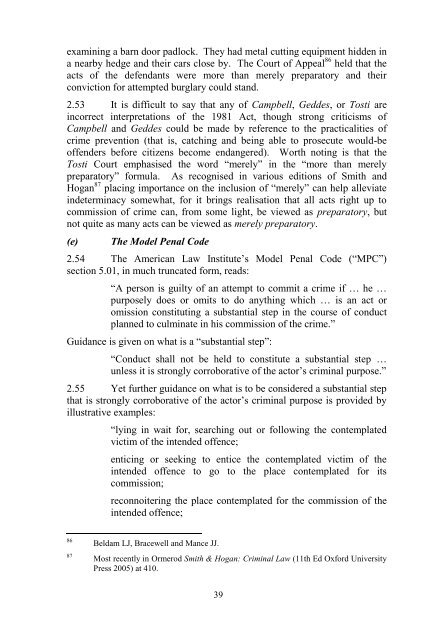Consultation Paper on Inchoate Offences - Law Reform Commission
Consultation Paper on Inchoate Offences - Law Reform Commission
Consultation Paper on Inchoate Offences - Law Reform Commission
Create successful ePaper yourself
Turn your PDF publications into a flip-book with our unique Google optimized e-Paper software.
examining a barn door padlock. They had metal cutting equipment hidden ina nearby hedge and their cars close by. The Court of Appeal 86 held that theacts of the defendants were more than merely preparatory and theirc<strong>on</strong>victi<strong>on</strong> for attempted burglary could stand.2.53 It is difficult to say that any of Campbell, Geddes, or Tosti areincorrect interpretati<strong>on</strong>s of the 1981 Act, though str<strong>on</strong>g criticisms ofCampbell and Geddes could be made by reference to the practicalities ofcrime preventi<strong>on</strong> (that is, catching and being able to prosecute would-beoffenders before citizens become endangered). Worth noting is that theTosti Court emphasised the word “merely” in the “more than merelypreparatory” formula. As recognised in various editi<strong>on</strong>s of Smith andHogan 87 placing importance <strong>on</strong> the inclusi<strong>on</strong> of “merely” can help alleviateindeterminacy somewhat, for it brings realisati<strong>on</strong> that all acts right up tocommissi<strong>on</strong> of crime can, from some light, be viewed as preparatory, butnot quite as many acts can be viewed as merely preparatory.(e)The Model Penal Code2.54 The American <strong>Law</strong> Institute‟s Model Penal Code (“MPC”)secti<strong>on</strong> 5.01, in much truncated form, reads:“A pers<strong>on</strong> is guilty of an attempt to commit a crime if … he …purposely does or omits to do anything which … is an act oromissi<strong>on</strong> c<strong>on</strong>stituting a substantial step in the course of c<strong>on</strong>ductplanned to culminate in his commissi<strong>on</strong> of the crime.”Guidance is given <strong>on</strong> what is a “substantial step”:“C<strong>on</strong>duct shall not be held to c<strong>on</strong>stitute a substantial step …unless it is str<strong>on</strong>gly corroborative of the actor‟s criminal purpose.”2.55 Yet further guidance <strong>on</strong> what is to be c<strong>on</strong>sidered a substantial stepthat is str<strong>on</strong>gly corroborative of the actor‟s criminal purpose is provided byillustrative examples:“lying in wait for, searching out or following the c<strong>on</strong>templatedvictim of the intended offence;enticing or seeking to entice the c<strong>on</strong>templated victim of theintended offence to go to the place c<strong>on</strong>templated for itscommissi<strong>on</strong>;rec<strong>on</strong>noitering the place c<strong>on</strong>templated for the commissi<strong>on</strong> of theintended offence;8687Beldam LJ, Bracewell and Mance JJ.Most recently in Ormerod Smith & Hogan: Criminal <strong>Law</strong> (11th Ed Oxford UniversityPress 2005) at 410.39
















